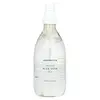What's inside
What's inside
 Key Ingredients
Key Ingredients

No key ingredients
 Benefits
Benefits

 Concerns
Concerns

No concerns
 Ingredients Side-by-side
Ingredients Side-by-side

Water
Skin ConditioningAlcohol Denat.
AntimicrobialGlycerin
HumectantPolysorbate 20
EmulsifyingCarbomer
Emulsion StabilisingDisodium EDTA
Betaine
HumectantButylene Glycol
HumectantAloe Barbadensis Leaf Extract
EmollientPortulaca Oleracea Extract
Skin ConditioningOcimum Basilicum Leaf Extract
Skin ConditioningSalvia Officinalis Leaf Extract
CleansingMentha Viridis Extract
MaskingOriganum Vulgare Leaf Extract
Skin ConditioningMelilotus Officinalis Extract
AstringentSarothamnus Scoparius Extract
AntioxidantEthylhexylglycerin
Skin ConditioningAngelica Dahurica Root Extract
Skin ConditioningChrysanthemum Morifolium Flower Extract
Skin ConditioningChamomilla Recutita Leaf Extract
MaskingHippophae Rhamnoides Extract
MaskingMorus Alba Root Extract
BleachingThuja Occidentalis Leaf Extract
AntioxidantVitex Trifolia Fruit Extract
Skin ConditioningUrtica Dioica Extract
AstringentPersea Gratissima Fruit Extract
EmollientSambucus Nigra Fruit Extract
AstringentAsarum Sieboldii Root Extract
Skin ConditioningCnidium Officinale Root Extract
Skin ConditioningEclipta Prostrata Extract
Skin ConditioningJuglans Regia Seed Extract
Skin ConditioningSimmondsia Chinensis Seed Extract
AbrasivePhenoxyethanol
PreservativeChlorphenesin
AntimicrobialPotassium Hydroxide
BufferingParfum
MaskingWater, Alcohol Denat., Glycerin, Polysorbate 20, Carbomer, Disodium EDTA, Betaine, Butylene Glycol, Aloe Barbadensis Leaf Extract, Portulaca Oleracea Extract, Ocimum Basilicum Leaf Extract, Salvia Officinalis Leaf Extract, Mentha Viridis Extract, Origanum Vulgare Leaf Extract, Melilotus Officinalis Extract, Sarothamnus Scoparius Extract, Ethylhexylglycerin, Angelica Dahurica Root Extract, Chrysanthemum Morifolium Flower Extract, Chamomilla Recutita Leaf Extract, Hippophae Rhamnoides Extract, Morus Alba Root Extract, Thuja Occidentalis Leaf Extract, Vitex Trifolia Fruit Extract, Urtica Dioica Extract, Persea Gratissima Fruit Extract, Sambucus Nigra Fruit Extract, Asarum Sieboldii Root Extract, Cnidium Officinale Root Extract, Eclipta Prostrata Extract, Juglans Regia Seed Extract, Simmondsia Chinensis Seed Extract, Phenoxyethanol, Chlorphenesin, Potassium Hydroxide, Parfum
Ingredients Explained
These ingredients are found in both products.
Ingredients higher up in an ingredient list are typically present in a larger amount.
Aloe Barbadensis Leaf Extract is an extract of the leaves of the aloe, Aloe barbadensis, Liliaceae.
Aloe is one of the most well-known natural soothing ingredients, and for good reason. It’s full of water and has a cooling, calming effect on the skin, especially when it’s sunburned, itchy, or irritated. Aloe also helps your skin stay hydrated and smooth by mimicking what healthy skin naturally produces. On top of that, it contains vitamins and nutrients that support skin recovery.
It doesn’t protect you from the sun, but it can help your skin bounce back after too much time in it.
Let’s get into the details:
Aloe contains antioxidant Vitamins A, C, and E, which help fight off free radicals (unstable molecules from things like pollution that can damage your skin).
It’s also rich in polysaccharides, which are natural sugars that help hydrate the skin by acting like the skin’s own moisturizing agents. These, along with other sugars like monosaccharides, help form a protective barrier that locks in moisture.
Aloe works as both a humectant and an emollient. That means it draws water into the skin (humectant) and helps trap it there (emollient), making it an effective natural moisturizer.
You’ll also find a mix of other skin-supporting ingredients in aloe, including folic acid, choline, calcium, amino acids, fatty acids, and even Vitamin B12.
Out of the 420+ species of aloe, Aloe barbadensis is the most widely used in skincare products thanks to its gentle yet effective properties.
There are over 420 species of aloe but Aloe Barbadensis is the most commonly used for topical products.
Learn more about Aloe Barbadensis Leaf ExtractButylene Glycol (or BG) is used within cosmetic products for a few different reasons:
Overall, Butylene Glycol is a safe and well-rounded ingredient that works well with other ingredients.
Though this ingredient works well with most skin types, some people with sensitive skin may experience a reaction such as allergic rashes, closed comedones, or itchiness.
Learn more about Butylene Glycol